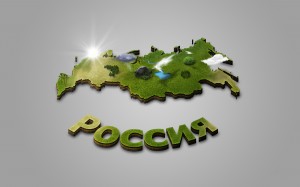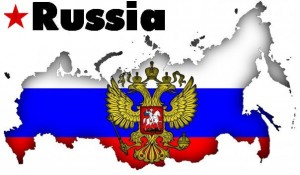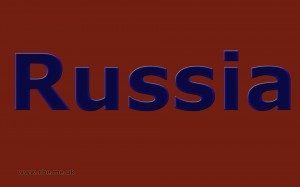40. Russia
Russian Federation
~~~~~~~~~~~~~~~~~~~~~~~~~~~~~~~~~~~~~~~~~~~~~~~~~~~~~~~~~~~~~~~~~~~~~~~~~~~~~~~~~~~~
~~~~~~~~~~~~~~~~~~~~~~~~~~~~~~~~~~~~~~~~~~~~~~~~~~~~~~~~~~~~~~~~~~~~~~~~~~~~~~~~~~~~
Area: 17 million sq. km. (6.5 million sq. mi.); about 1.8 times the size of the United States.
Cities: Capital–Moscow (pop. 10.4 million). Other cities–St. Petersburg (4.6 million), Novosibirsk (1.4 million), Nizhniy Novgorod (1.3 million).
Terrain: Broad plain with low hills west of Urals; vast coniferous forest and tundra in Siberia; uplands and mountains (Caucasus range) along southern borders.
Climate: Northern continental.
Nationality: Noun and adjective–Russian(s).
Population (August 2011): 142.9 million.
Annual population growth rate (2011 est.): -0.07%.
Ethnic groups (2002 census): Russian 79.8%, Tatar 3.8%, Ukrainian 2%, Bashkir 1.2%, Chuvash 1.1%, other 12.1%.
Religion: Russian Orthodox, Islam, Judaism, Roman Catholicism, Protestant, Buddhist, other.
Language: Russian (official); more than 140 other languages and dialects.
Education (total pop.): Literacy–99.4%.
Health: Life expectancy (2011 est.)–63.03 years men, 74.87 years women.
Work force (75.49 million, 2010 est.): Services–58.1%, industry–31.9%, agriculture–10%.
Government
Type: Federation.
Independence: August 24, 1991.
Constitution: December 12, 1993.
Branches: Executive–president, prime minister (chairman of the government). Legislative–Federal Assembly (Federation Council, State Duma). Judicial–Constitutional Court, Supreme Court, Supreme Court of Arbitration, Office of Procurator General.
Political parties: After a shakeup in late 2008 dissolved and combined several parties, seven registered parties remained: United Russia, the Communist Party (KPRF), the Liberal Democratic Party (LDPR), Just Russia, Yabloko, Patriots of Russia, and the new Right Cause party. Yabloko, which favors liberal reforms, and Patriots of Russia failed to clear the 7% threshold in 2007 to enter the Duma. The next round of Duma elections will be held on December 4, 2011.
Subdivisions: 83 federal subjects (members of the Federation), including 21 republics, 9 krays, 46 oblasts, 2 federal cities, 1 autonomous oblast, and 4 autonomous okrugs.
Suffrage: Universal at 18 years.
Economy
GDP (2010): $1.477 trillion.
Growth rate (2011): 4%.
Natural resources: Petroleum, natural gas, timber, furs, precious and nonferrous metals.
Agriculture: Products–Grain, sugar beets, sunflower seeds, meat, dairy products.
Industry: Types–Complete range of manufactures: automobiles, trucks, trains, agricultural equipment, advanced aircraft, aerospace, machine and equipment products; mining and extractive industry; medical and scientific instruments; construction equipment.
Trade (2010): Exports–$376.7 billion: petroleum and petroleum products, natural gas, woods and wood products, metals, chemicals. Major markets–EU, CIS, China, Japan.Imports–$191.8 billion: machinery and equipment, chemicals, consumer goods, medicines, meat, sugar, semi-finished metal products. Major partners–EU, CIS, Japan, China, U.S. U.S. exports–$6.0 billion. Principal U.S. exports to Russia (2010)–oil/gas equipment, meat, motor vehicles and parts, aircraft, electrical machinery, automatic data processing machines and parts, medical equipment, plastics, cosmetics, and chemicals.U.S. imports–$25.7 billion. Principal U.S. imports from Russia (2010)–oil, chemicals (including fertilizer), radioactive materials, iron/steel, precious stones, nickel, aluminum, fish and crustaceans, alcoholic beverages, and base metals.
PEOPLE
Russia’s 142.9 million citizens descend from more than 100 ethnic groups. Russian is the official language of Russia and is one of the six official languages of the United Nations. Russian is also the language of such giants of world literature as Pushkin, Tolstoy, Dostoevsky, Chekhov, Pasternak, and Solzhenitsyn.
Russia’s educational system has produced nearly 100% literacy. About 8.1 million students attended Russia’s 1,108 institutions of higher education in 2008, but continued reform is critical to producing students with skills to adapt to a market economy. Because great emphasis is placed on science and technology in education, Russian mathematical, scientific, and space and aviation research is still generally of a high order. The number of doctors in relation to the population is high by American standards, although medical care in Russia, even in major cities, is generally far below Western standards. The unraveling of the Soviet state in its last decades and the physical and psychological traumas of transition during the 1990s resulted in a steady decline in the health of the Russian people. Currently Russia faces a demographic crisis as births lag far behind deaths. While its population is aging, the high number of deaths of working-age males due to cardiovascular disease is a major cause of Russia’s demographic woes. A rapid increase in HIV/AIDS infections and tuberculosis, added to rising deaths from cancer, compounds the problem. In 2011, life expectancy at birth was estimated at 63.03 years for men and 74.87 years for women. The large annual excess of deaths over births, if unabated, could cut Russia’s population by 30% over the next 50 years, though inward migration could change this picture. At the end of 2010, there were 60 million Internet users in Russia, with the number growing by 15% a year. Industry watchers forecast that Russia will be Europe’s largest Internet market within the next 2 years.
The Russian labor force, amounting to nearly 76 million workers in 2010, is undergoing tremendous changes. Although well educated and skilled, it is largely mismatched to the rapidly changing needs of the Russian economy. Official unemployment dropped to its lowest rate of 5.4% in May 2008, and labor shortages appeared in some high-skilled job markets. The economic crisis that began in late 2008, however, quickly reversed this trend and the ranks of unemployed swelled to an International Labor Organization (ILO)-estimated 8.2% in 2009; 1.8 million Russians lost their jobs in the first quarter of 2009 alone. By the end of 2010, the Russian economy showed signs of recovery, with the unemployment rate falling to 7.4% by the end of the second quarter, according to the Russian Government statistics agency, Rosstat. Following the 1991 collapse of the Soviet Union and the economic dislocation it engendered, the standard of living fell dramatically. Real disposable incomes then doubled between 1999 and 2009, and experts estimate that the middle class constitutes approximately one-fourth of the population. The economic crisis, however, interrupted this trend, as real disposable incomes grew by only 1.9% in 2009 and wages fell by 2.8% during the same period. The stock of wage arrears, which peaked during the crisis at almost 9 billion rubles, had fallen by almost half by February 2010. Government anti-crisis measures to bolster wages, pensions, and other benefits helped reduce the poverty rate in 2009 to an estimated 14%, bringing the number of people living below the subsistence minimum (equivalent to about $169 per month) to below 20 million. The official poverty rate was estimated as 13.1% by the World Bank at the end of 2010. According to Russian statistics, the poverty level increased to 14.9% of the population in the first half of 2011 because of an increase in the official poverty threshold and because average real income fell slightly in 2011.
Moscow is Russia’s capital and largest city. Moscow is also increasingly important as an economic and business center; it has become Russia’s principal magnet for foreign investment and business presence. Its cultural tradition is rich, and there are many museums devoted to art, literature, music, dance, history, and science, as well as hundreds of churches and dozens of notable cathedrals.
The second-largest city in Russia is St. Petersburg, which was established by Peter the Great in 1703 to be the capital of the Russian Empire as part of his Western-looking reforms. The city was called Petrograd during World War I and Leningrad after 1924. In 1991, as the result of a city referendum, it was renamed St. Petersburg. Under the tsars, the city was Russia’s cultural, intellectual, commercial, financial, and industrial center. After Lenin moved the capital back to Moscow in 1918, the city’s political significance declined, but it remained a cultural, scientific, and military-industrial center. The Hermitage, formerly the Winter Palace of the tsars, is one of the world’s great fine arts museums.
Russia has an area of about 17 million square kilometers (6.5 million sq. mi.); in geographic terms, this makes Russia the largest country in the world by more than 2.5 million square miles. But with a population density of about 22 persons per square mile (9 per sq. km.), it is sparsely populated, and most of its residents live in urban areas.
~~~~~~~~~~~~~~~~~~~~~~~~~~~~~~~~~~~~~~~~~~~~~~~~~~~~~~~~~~~~~~~~~~~~~~~~~~~~~~~~~~~~
~~~~~~~~~~~~~~~~~~~~~~~~~~~~~~~~~~~~~~~~~~~~~~~~~~~~~~~~~~~~~~~~~~~~~~~~~~~~~~~~~~~~
~~~~~~~~~~~~~~~~~~~~~~~~~~~~~~~~~~~~~~~~~~~~~~~~~~~~~~~~~~~~~~~~~~~~~~~~~~~~~~~~~~~~
~~~~~~~~~~~~~~~~~~~~~~~~~~~~~~~~~~~~~~~~~~~~~~~~~~~~~~~~~~~~~~~~~~~~~~~~~~~~~~~~~~~~
3. Real Russia 2. Russian Federation 1. Russia~~~~~~~~~~~~~~~~~~~~~~~~~~~~~~~~~~~~~~~~~~~~~~~~~~~~~~~~~~~~~~~~~~~~~~~~~~~~~~~~~~~~
~~~~~~~~~~~~~~~~~~~~~~~~~~~~~~~~~~~~~~~~~~~~~~~~~~~~~~~~~~~~~~~~~~~~~~~~~~~~~~~~~~~~
~~~~~~~~~~~~~~~~~~~~~~~~~~~~~~~~~~~~~~~~~~~~~~~~~~~~~~~~~~~~~~~~~~~~~~~~~~~~~~~~~~~~
~~~~~~~~~~~~~~~~~~~~~~~~~~~~~~~~~~~~~~~~~~~~~~~~~~~~~~~~~~~~~~~~~~~~~~~~~~~~~~~~~~~~
2012
~~~~~~~~~~~~~~~~~~~~~~~~~~~~~~~~~~~~~~~~~~~~~~~~~~~~~~~~~~~~~~~~~~~~~~~~~~~~~~~~~~~~
~~~~~~~~~~~~~~~~~~~~~~~~~~~~~~~~~~~~~~~~~~~~~~~~~~~~~~~~~~~~~~~~~~~~~~~~~~~~~~~~~~~~
~~~~~~~~~~~~~~~~~~~~~~~~~~~~~~~~~~~~~~~~~~~~~~~~~~~~~~~~~~~~~~~~~~~~~~~~~~~~~~~~~~~~
~~~~~~~~~~~~~~~~~~~~~~~~~~~~~~~~~~~~~~~~~~~~~~~~~~~~~~~~~~~~~~~~~~~~~~~~~~~~~~~~~~~~
~~~~~~~~~~~~~~~~~~~~~~~~~~~~~~~~~~~~~~~~~~~~~~~~~~~~~~~~~~~~~~~~~~~~~~~~~~~~~~~~~~~~
~~~~~~~~~~~~~~~~~~~~~~~~~~~~~~~~~~~~~~~~~~~~~~~~~~~~~~~~~~~~~~~~~~~~~~~~~~~~~~~~~~~~
~~~~~~~~~~~~~~~~~~~~~~~~~~~~~~~~~~~~~~~~~~~~~~~~~~~~~~~~~~~~~~~~~~~~~~~~~~~~~~~~~~~~
~~~~~~~~~~~~~~~~~~~~~~~~~~~~~~~~~~~~~~~~~~~~~~~~~~~~~~~~~~~~~~~~~~~~~~~~~~~~~~~~~~~~
~~~~~~~~~~~~~~~~~~~~~~~~~~~~~~~~~~~~~~~~~~~~~~~~~~~~~~~~~~~~~~~~~~~~~~~~~~~~~~~~~~~~
~~~~~~~~~~~~~~~~~~~~~~~~~~~~~~~~~~~~~~~~~~~~~~~~~~~~~~~~~~~~~~~~~~~~~~~~~~~~~~~~~~~~
~~~~~~~~~~~~~~~~~~~~~~~~~~~~~~~~~~~~~~~~~~~~~~~~~~~~~~~~~~~~~~~~~~~~~~~~~~~~~~~~~~~~
~~~~~~~~~~~~~~~~~~~~~~~~~~~~~~~~~~~~~~~~~~~~~~~~~~~~~~~~~~~~~~~~~~~~~~~~~~~~~~~~~~~~
~~~~~~~~~~~~~~~~~~~~~~~~~~~~~~~~~~~~~~~~~~~~~~~~~~~~~~~~~~~~~~~~~~~~~~~~~~~~~~~~~~~~
~~~~~~~~~~~~~~~~~~~~~~~~~~~~~~~~~~~~~~~~~~~~~~~~~~~~~~~~~~~~~~~~~~~~~~~~~~~~~~~~~~~~







